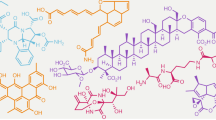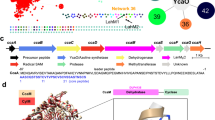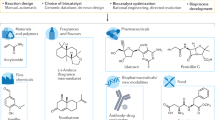Abstract
The avalanche of genomic information in the past decade has revealed that natural product biosynthesis using the ribosomal machinery is much more widespread than originally anticipated. Nearly all of these compounds are crafted through post-translational modifications of a larger precursor peptide that often contains the marching orders for the biosynthetic enzymes. We review here the available information for how the peptide sequences in the precursors govern the post-translational tailoring processes for several classes of natural products. In addition, we highlight the great potential these leader peptide–directed biosynthetic systems offer for engineering conformationally restrained and pharmacophore-rich products with structural diversity that greatly expands the proteinogenic repertoire.
This is a preview of subscription content, access via your institution
Access options
Subscribe to this journal
Receive 12 print issues and online access
$259.00 per year
only $21.58 per issue
Buy this article
- Purchase on Springer Link
- Instant access to full article PDF
Prices may be subject to local taxes which are calculated during checkout






Similar content being viewed by others
References
Bode, H.B. & Muller, R. The impact of bacterial genomics on natural product research. Angew. Chem. Int. Edn Engl. 44, 6828–6846 (2005).
Schmidt, E.W. et al. Patellamide A and C biosynthesis by a microcin-like pathway in Prochloron didemni, the cyanobacterial symbiont of Lissoclinum patella. Proc. Natl. Acad. Sci. USA 102, 7315–7320 (2005).
McClerren, A.L. et al. Discovery and in vitro biosynthesis of haloduracin, a new two-component lantibiotic. Proc. Natl. Acad. Sci. USA 103, 17243–17248 (2006).
Lawton, E.M., Cotter, P.D., Hill, C. & Ross, R.P. Identification of a novel two-peptide lantibiotic, Haloduracin, produced by the alkaliphile Bacillus halodurans C-125. FEMS Microbiol. Lett. 267, 64–71 (2007).
Hallen, H.E., Luo, H., Scott-Craig, J.S. & Walton, J.D. Gene family encoding the major toxins of lethal Amanita mushrooms. Proc. Natl. Acad. Sci. USA 104, 19097–19101 (2007).
Lee, S.W. et al. Discovery of a widely distributed toxin biosynthetic gene cluster. Proc. Natl. Acad. Sci. USA 105, 5879–5884 (2008).
Cotter, P.D. et al. Listeriolysin S, a novel peptide haemolysin associated with a subset of lineage I Listeria monocytogenes. PLoS Pathog. 4, e1000144 (2008).
Ziemert, N., Ishida, K., Liaimer, A., Hertweck, C. & Dittmann, E. Ribosomal synthesis of tricyclic depsipeptides in bloom-forming cyanobacteria. Angew. Chem. Int. Edn Engl. 47, 7756–7759 (2008).
Philmus, B., Christiansen, G., Yoshida, W.Y. & Hemscheidt, T.K. Post-translational modification in microviridin biosynthesis. ChemBioChem 9, 3066–3073 (2008).
Wieland Brown, L.C., Acker, M.G., Clardy, J., Walsh, C.T. & Fischbach, M.A. Thirteen posttranslational modifications convert a 14-residue peptide into the antibiotic thiocillin. Proc. Natl. Acad. Sci. USA 106, 2549–2553 (2009).
Kelly, W.L., Pan, L. & Li, C. Thiostrepton biosynthesis: prototype for a new family of bacteriocins. J. Am. Chem. Soc. 131, 4327–4334 (2009).
Liao, R. et al. Thiopeptide biosynthesis featuring ribosomally synthesized precursor peptides and conserved posttranslational modifications. Chem. Biol. 16, 141–147 (2009).
Morris, R.P. et al. Ribosomally synthesized thiopeptide antibiotics targeting elongation factor Tu. J. Am. Chem. Soc. 131, 5946–5955 (2009).
McIntosh, J.A., Donia, M.S. & Schmidt, E.W. Ribosomal peptide natural products: bridging the ribosomal and nonribosomal worlds. Nat. Prod. Rep. 26, 537–559 (2009).
Braun, P. & Tommassen, J. Function of bacterial propeptides. Trends Microbiol. 6, 6–8 (1998).
Willey, J.M. & van der Donk, W.A. Lantibiotics: peptides of diverse structure and function. Annu. Rev. Microbiol. 61, 477–501 (2007).
Lubelski, J., Rink, R., Khusainov, R., Moll, G.N. & Kuipers, O.P. Biosynthesis, immunity, regulation, mode of action and engineering of the model lantibiotic nisin. Cell. Mol. Life Sci. 65, 455–476 (2008).
van den Hooven, H.W., Rollema, H.S., Siezen, R.J., Hilbers, C.W. & Kuipers, O.P. Structural features of the final intermediate in the biosynthesis of the lantibiotic nisin. Influence of the leader peptide. Biochemistry 36, 14137–14145 (1997).
Beck-Sickinger, A.G. & Jung, G. Synthesis and conformational analysis of lantibiotic leader-, pro- and pre-peptides. in Nisin and Novel Lantibiotics (eds. Jung, G. & Sahl, H.-G.) 218–230 (ESCOM, Leiden, The Netherlands, 1991).
van der Meer, J.R. et al. Influence of amino acid substitutions in the nisin leader peptide on biosynthesis and secretion of nisin by Lactococcus lactis. J. Biol. Chem. 269, 3555–3562 (1994).
Li, B. et al. Structure and mechanism of the lantibiotic cyclase involved in nisin biosynthesis. Science 311, 1464–1467 (2006).
Izaguirre, G. & Hansen, J.N. Use of alkaline phosphatase as a reporter polypeptide to study the role of the subtilin leader segment and the SpaT transporter in the posttranslational modifications and secretion of subtilin in Bacillus subtilis 168. Appl. Environ. Microbiol. 63, 3965–3971 (1997).
Kuipers, A. et al. NisT, the transporter of the lantibiotic nisin, can transport fully modified, dehydrated and unmodified prenisin and fusions of the leader peptide with non-lantibiotic peptides. J. Biol. Chem. 279, 22176–22182 (2004).
Rink, R. et al. Production of dehydroamino acid-containing peptides by Lactococcus lactis. Appl. Environ. Microbiol. 73, 1792–1796 (2007).
Kluskens, L.D. et al. Post-translational modification of therapeutic peptides by NisB, the dehydratase of the lantibiotic nisin. Biochemistry 44, 12827–12834 (2005).
Håvarstein, L.S., Holo, H. & Nes, I.F. The leader peptide of colicin V shares consensus sequences with leader peptides that are common among peptide bacteriocins produced by gram-positive bacteria. Microbiology 140, 2383–2389 (1994).
Xie, L. et al. Lacticin 481: in vitro reconstitution of lantibiotic synthetase activity. Science 303, 679–681 (2004).
Levengood, M.R., Patton, G.C. & van der Donk, W.A. The leader peptide is not required for post-translational modification by lacticin 481 synthetase. J. Am. Chem. Soc. 129, 10314–10315 (2007).
Patton, G.C., Paul, M., Cooper, L.E., Chatterjee, C. & van der Donk, W.A. The importance of the leader sequence for directing lanthionine formation in lacticin 481. Biochemistry 47, 7342–7351 (2008).
Lee, M.V. et al. Distributive and directional behavior of lantibiotic synthetases revealed by high-resolution tandem mass spectrometry. J. Am. Chem. Soc. 131, 12258–12264 (2009).
Chen, P., Qi, F.X., Novak, J., Krull, R.E. & Caufield, P.W. Effect of amino acid substitutions in conserved residues in the leader peptide on biosynthesis of the lantibiotic mutacin II. FEMS Microbiol. Lett. 195, 139–144 (2001).
Furgerson Ihnken, L.A., Chatterjee, C. & van der Donk, W.A. In vitro reconstitution and substrate specificity of a lantibiotic protease. Biochemistry 47, 7352–7363 (2008).
Sprules, T., Kawulka, K.E., Gibbs, A.C., Wishart, D.S. & Vederas, J.C. NMR solution structure of the precursor for carnobacteriocin B2, an antimicrobial peptide from Carnobacterium piscicola. Eur. J. Biochem. 271, 1748–1756 (2004).
Duquesne, S., Destoumieux-Garzon, D., Peduzzi, J. & Rebuffat, S. Microcins, gene-encoded antibacterial peptides from enterobacteria. Nat. Prod. Rep. 24, 708–734 (2007).
Bayer, A., Freund, S. & Jung, G. Posttranslational backbone modifications in the ribosomal biosynthesis of the glycine-rich antibiotic microcin B17. Angew. Chem. Int. Edn Engl. 32, 1336–1339 (1993).
Wilson, K.A. et al. Structure of microcin J25, a peptide inhibitor of bacterial RNA polymerase, is a lassoed tail. J. Am. Chem. Soc. 125, 12475–12483 (2003).
Bayro, M.J. et al. Structure of antibacterial peptide microcin J25: a 21-residue lariat protoknot. J. Am. Chem. Soc. 125, 12382–12383 (2003).
Rosengren, K.J. et al. Microcin J25 has a threaded sidechain-to-backbone ring structure and not a head-to-tail cyclized backbone. J. Am. Chem. Soc. 125, 12464–12474 (2003).
Thomas, X. et al. Siderophore peptide, a new type of post-translationally modified antibacterial peptide with potent activity. J. Biol. Chem. 279, 28233–28242 (2004).
Guijarro, J.I. et al. Chemical structure and translation inhibition studies of the antibiotic microcin C7. J. Biol. Chem. 270, 23520–23532 (1995).
Nolan, E.M., Fischbach, M.A., Koglin, A. & Walsh, C.T. Biosynthetic tailoring of microcin E492m: post-translational modification affords an antibacterial siderophore-peptide conjugate. J. Am. Chem. Soc. 129, 14336–14347 (2007).
Li, Y.M., Milne, J.C., Madison, L.L., Kolter, R. & Walsh, C.T. From peptide precursors to oxazole and thiazole-containing peptide antibiotics: microcin B17 synthase. Science 274, 1188–1193 (1996).
Madison, L.L., Vivas, E.I., Li, Y.M., Walsh, C.T. & Kolter, R. The leader peptide is essential for the post-translational modification of the DNA-gyrase inhibitor microcin B17. Mol. Microbiol. 23, 161–168 (1997).
Yorgey, P., Davagnino, J. & Kolter, R. The maturation pathway of microcin B17, a peptide inhibitor of DNA gyrase. Mol. Microbiol. 9, 897–905 (1993).
Roy, R.S., Kim, S., Baleja, J.D. & Walsh, C.T. Role of the microcin B17 propeptide in substrate recognition: solution structure and mutational analysis of McbA1–26. Chem. Biol. 5, 217–228 (1998).
Milne, J.C. et al. Cofactor requirements and reconstitution of microcin B17 synthetase: a multienzyme complex that catalyzes the formation of oxazoles and thiazoles in the antibiotic microcin B17. Biochemistry 38, 4768–4781 (1999).
Sinha Roy, R., Belshaw, P.J. & Walsh, C.T. Mutational analysis of posttranslational heterocycle biosynthesis in the gyrase inhibitor microcin B17: distance dependence from propeptide and tolerance for substitution in a GSCG cyclizable sequence. Biochemistry 37, 4125–4136 (1998).
Kelleher, N.L., Hendrickson, C.L. & Walsh, C.T. Posttranslational heterocyclization of cysteine and serine residues in the antibiotic microcin B17: distributivity and directionality. Biochemistry 38, 15623–15630 (1999).
Duquesne, S. et al. Two enzymes catalyze the maturation of a lasso peptide in Escherichia coli. Chem. Biol. 14, 793–803 (2007).
Tsai, C.J., Ma, B. & Nussinov, R. Intra-molecular chaperone: the role of the N-terminal in conformational selection and kinetic control. Phys. Biol. 6, 13001 (2009).
Nizet, V. et al. Genetic locus for streptolysin S production by group A streptococcus. Infect. Immun. 68, 4245–4254 (2000).
Mitchell, D.A. et al. Structural and functional dissection of the heterocyclic peptide cytotoxin streptolysin S. J. Biol. Chem. 284, 13004–13012 (2009).
Onaka, H., Nakaho, M., Hayashi, K., Igarashi, Y. & Furumai, T. Cloning and characterization of the goadsporin biosynthetic gene cluster from Streptomyces sp. TP-A0584. Microbiology 151, 3923–3933 (2005).
Long, P.F., Dunlap, W.C., Battershill, C.N. & Jaspars, M. Shotgun cloning and heterologous expression of the patellamide gene cluster as a strategy to achieving sustained metabolite production. ChemBioChem 6, 1760–1765 (2005).
Ziemert, N. et al. Microcyclamide biosynthesis in two strains of Microcystis aeruginosa: from structure to genes and vice versa. Appl. Environ. Microbiol. 74, 1791–1797 (2008).
Donia, M.S., Ravel, J. & Schmidt, E.W. A global assembly line for cyanobactins. Nat. Chem. Biol. 4, 341–343 (2008).
Donia, M.S. et al. Natural combinatorial peptide libraries in cyanobacterial symbionts of marine ascidians. Nat. Chem. Biol. 2, 729–735 (2006).
Lee, J., McIntosh, J., Hathaway, B.J. & Schmidt, E.W. Using marine natural products to discover a protease that catalyzes peptide macrocyclization of diverse substrates. J. Am. Chem. Soc. 131, 2122–2124 (2009).
Luo, H., Hallen-Adams, H.E. & Walton, J.D. Processing of the phalloidin proprotein by prolyl oligopeptidase from the mushroom Conocybe albipes. J. Biol. Chem. 284, 18070–18077 (2009).
Gruber, C.W. et al. Distribution and evolution of circular miniproteins in flowering plants. Plant Cell 20, 2471–2483 (2008).
Jennings, C., West, J., Waine, C., Craik, D. & Anderson, M. Biosynthesis and insecticidal properties of plant cyclotides: the cyclic knotted proteins from Oldenlandia affinis. Proc. Natl. Acad. Sci. USA 98, 10614–10619 (2001).
Dutton, J.L. et al. Conserved structural and sequence elements implicated in the processing of gene-encoded circular proteins. J. Biol. Chem. 279, 46858–46867 (2004).
Saska, I. et al. An asparaginyl endopeptidase mediates in vivo protein backbone cyclization. J. Biol. Chem. 282, 29721–29728 (2007).
Bagley, M.C., Dale, J.W., Merritt, E.A. & Xiong, X. Thiopeptide antibiotics. Chem. Rev. 105, 685–714 (2005).
Yu, Y. et al. Nosiheptide biosynthesis featuring a unique indole side ring formation on the characteristic thiopeptide framework. ACS Chem. Biol. 4, 855–864 (2009).
Philmus, B., Guerrette, J.P. & Hemscheidt, T.K. Substrate specificity and scope of MvdD, a GRASP-like ligase from the microviridin biosynthetic gene cluster. ACS Chem. Biol. 4, 429–434 (2009).
Buczek, O., Bulaj, G. & Olivera, B.M. Conotoxins and the posttranslational modification of secreted gene products. Cell. Mol. Life Sci. 62, 3067–3079 (2005).
Halai, R. & Craik, D.J. Conotoxins: natural product drug leads. Nat. Prod. Rep. 26, 526–536 (2009).
Woodward, S.R., Cruz, L.J., Olivera, B.M. & Hillyard, D.R. Constant and hypervariable regions in conotoxin propeptides. EMBO J. 9, 1015–1020 (1990).
Craig, A.G., Pradip, B. & Baldomero, M.O. Post-translationally modified neuropeptides from Conus venoms. Eur. J. Biochem. 264, 271–275 (1999).
Brown, M.A. et al. Precursors of novel Gla-containing conotoxins contain a carboxy-terminal recognition site that directs gamma-carboxylation. Biochemistry 44, 9150–9159 (2005).
Olivera, B.M. et al. Speciation of cone snails and interspecific hyperdivergence of their venom peptides. Potential evolutionary significance of introns. Ann. NY Acad. Sci. 870, 223–237 (1999).
McIntosh, J.M., Olivera, B.M., Cruz, L.J. & Gray, W.R. Gamma-carboxyglutamate in a neuroactive toxin. J. Biol. Chem. 259, 14343–14346 (1984).
Bulaj, G. Formation of disulfide bonds in proteins and peptides. Biotechnol. Adv. 23, 87–92 (2005).
Bandyopadhyay, P.K. et al. Conantokin-G precursor and its role in gamma-carboxylation by a vitamin K-dependent carboxylase from a Conus snail. J. Biol. Chem. 273, 5447–5450 (1998).
Czerwiec, E. et al. Novel gamma-carboxyglutamic acid-containing peptides from the venom of Conus textile. FEBS J. 273, 2779–2788 (2006).
Bulaj, G. et al. Efficient oxidative folding of conotoxins and the radiation of venomous cone snails. Proc. Natl. Acad. Sci. USA 100, 14562–14568 (2003).
Buczek, O., Olivera, B.M. & Bulaj, G. Propeptide does not act as an intramolecular chaperone but facilitates protein disulfide isomerase-assisted folding of a conotoxin precursor. Biochemistry 43, 1093–1101 (2004).
Milne, T.J., Abbenante, G., Tyndall, J.D.A., Halliday, J. & Lewis, R.J. Isolation and characterization of a cone snail protease with homology to CRISP proteins of the pathogenesis-related protein superfamily. J. Biol. Chem. 278, 31105–31110 (2003).
Craig, A.G. et al. A novel post-translational modification involving bromination of tryptophan. Identification of the residues, L-6-bromotryptophan, in peptides from Conus imperialis and Conus radiatus venom. J. Biol. Chem. 272, 4689–4698 (1997).
Pisarewicz, K., Mora, D., Pflueger, F.C., Fields, G.B. & Mari, F. Polypeptide chains containing D-gamma-hydroxyvaline. J. Am. Chem. Soc. 127, 6207–6215 (2005).
Lopez-Vera, E., Walewska, A., Skalicky, J.J., Olivera, B.M. & Bulaj, G. Role of hydroxyprolines in the in vitro oxidative folding and biological activity of conotoxins. Biochemistry 47, 1741–1751 (2008).
Maqueda, M. et al. Genetic features of circular bacteriocins produced by Gram-positive bacteria. FEMS Microbiol. Rev. 32, 2–22 (2008).
Kawulka, K. et al. Structure of subtilosin A, an antimicrobial peptide from Bacillus subtilis with unusual posttranslational modifications linking cysteine sulfurs to a-carbons of phenylalanine and threonine. J. Am. Chem. Soc. 125, 4726–4727 (2003).
Zheng, G., Yan, L.Z., Vederas, J.C. & Zuber, P. Genes of the sbo-alb locus of Bacillus subtilis are required for production of the antilisterial bacteriocin subtilosin. J. Bacteriol. 181, 7346–7355 (1999).
Molle, V. et al. The Spo0A regulon of Bacillus subtilis. Mol. Microbiol. 50, 1683–1701 (2003).
Okada, M. et al. Structure of the Bacillus subtilis quorum-sensing peptide pheromone ComX. Nat. Chem. Biol. 1, 23–24 (2005).
Zhang, L., Lin, J. & Ji, G. Membrane anchoring of the AgrD N-terminal amphipathic region is required for its processing to produce a quorum-sensing pheromone in Staphylococcus aureus. J. Biol. Chem. 279, 19448–19456 (2004).
Thoendel, M. & Horswill, A.R. Identification of Staphylococcus aureus AgrD residues required for autoinducing peptide biosynthesis. J. Biol. Chem. 284, 21828–21838 (2009).
Kuipers, O.P. et al. Protein engineering of lantibiotics. Antonie Van Leeuwenhoek 69, 161–169 (1996).
Chatterjee, C., Paul, M., Xie, L. & van der Donk, W.A. Biosynthesis and mode of action of lantibiotics. Chem. Rev. 105, 633–684 (2005).
Cortés, J., Appleyard, A.N. & Dawson, M.J. Whole-cell generation of lantibiotic variants. Methods Enzymol. 458, 559–574 (2009).
Cotter, P.D. et al. Complete alanine scanning of the two-component lantibiotic lacticin 3147: generating a blueprint for rational drug design. Mol. Microbiol. 62, 735–747 (2006).
Appleyard, A.N. et al. Dissecting structural and functional diversity of the lantibiotic mersacidin. Chem. Biol. 16, 490–498 (2009).
Liu, W. & Hansen, J.N. Enhancement of the chemical and antimicrobial properties of subtilin by site-directed mutagenesis. J. Biol. Chem. 267, 25078–25085 (1992).
Field, D., Connor, P.M., Cotter, P.D., Hill, C. & Ross, R.P. The generation of nisin variants with enhanced activity against specific gram-positive pathogens. Mol. Microbiol. 69, 218–230 (2008).
Rollema, H.S., Kuipers, O.P., Both, P., de Vos, W.M. & Siezen, R.J. Improvement of solubility and stability of the antimicrobial peptide nisin by protein engineering. Appl. Environ. Microbiol. 61, 2873–2878 (1995).
Levengood, M.R., Knerr, P.J., Oman, T.J. & van der Donk, W.A. In vitro mutasynthesis of lantibiotic analogues containing nonproteinogenic amino acids. J. Am. Chem. Soc. 131, 12024–12025 (2009).
Chatterjee, C., Patton, G.C., Cooper, L., Paul, M. & van der Donk, W.A. Engineering dehydro amino acids and thioethers into peptides using lacticin 481 synthetase. Chem. Biol. 13, 1109–1117 (2006).
Rink, R. et al. NisC, the cyclase of the lantibiotic nisin, can catalyze cyclization of designed nonlantibiotic peptides. Biochemistry 46, 13179–13189 (2007).
Levengood, M.R. & van der Donk, W.A. Use of lantibiotic synthetases for the preparation of bioactive constrained peptides. Bioorg. Med. Chem. Lett. 18, 3025–3028 (2008).
Sinha Roy, R., Kelleher, N.L., Milne, J.C. & Walsh, C.T. In vivo processing and antibiotic activity of microcin B17 analogs with varying ring content and altered bisheterocyclic sites. Chem. Biol. 6, 305–318 (1999).
Zamble, D.B. et al. In vitro characterization of DNA gyrase inhibition by microcin B17 analogs with altered bisheterocyclic sites. Proc. Natl. Acad. Sci. USA 98, 7712–7717 (2001).
Pavlova, O., Mukhopadhyay, J., Sineva, E., Ebright, R.H. & Severinov, K. Systematic structure-activity analysis of microcin J25. J. Biol. Chem. 283, 25589–25595 (2008).
Lubelski, J., Khusainov, R. & Kuipers, O.P. Directionality and coordination of dehydration and ring formation during biosynthesis of the lantibiotic nisin. J. Biol. Chem. 284, 25962–25972 (2009).
Crooks, G.E., Hon, G., Chandonia, J.M. & Brenner, S.E. WebLogo: a sequence logo generator. Genome Res. 14, 1188–1190 (2004).
Acknowledgements
Our work on LDB has been supported by the US National Institutes of Health (GM58822). We thank D. Mitchell (University of Illinois at Urbana-Champaign) for helpful discussions.
Author information
Authors and Affiliations
Corresponding author
Supplementary information
Supplementary Text and Figures
Supplementary Figures 1–12 (PDF 2209 kb)
Rights and permissions
About this article
Cite this article
Oman, T., van der Donk, W. Follow the leader: the use of leader peptides to guide natural product biosynthesis. Nat Chem Biol 6, 9–18 (2010). https://doi.org/10.1038/nchembio.286
Published:
Issue Date:
DOI: https://doi.org/10.1038/nchembio.286
This article is cited by
-
Use of the mCherry fluorescent protein to optimize the expression of class I lanthipeptides in Escherichia coli
Microbial Cell Factories (2023)
-
Discovery and biosynthesis of tricyclic copper-binding ribosomal peptides containing histidine-to-butyrine crosslinks
Nature Communications (2023)
-
Structural and biosynthetic diversity of plantaricins from Lactiplantibacillus
Applied Microbiology and Biotechnology (2023)
-
Phylogenomic analysis of the diversity of graspetides and proteins involved in their biosynthesis
Biology Direct (2022)
-
A scalable platform to discover antimicrobials of ribosomal origin
Nature Communications (2022)



